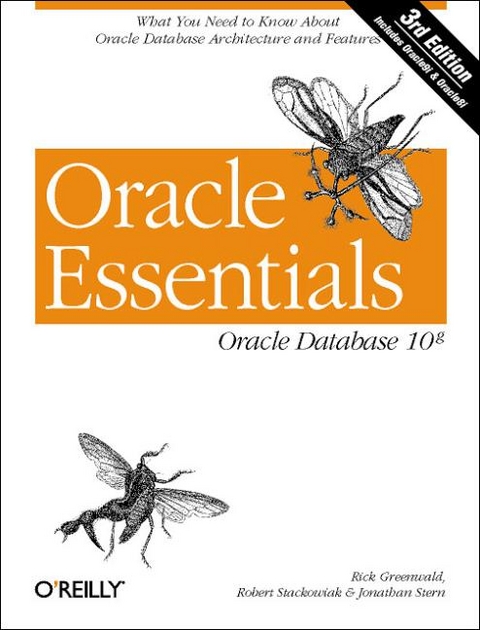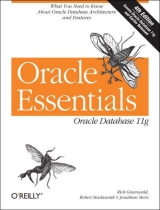
Oracle Essentials
O'Reilly Media (Verlag)
978-0-596-00585-6 (ISBN)
- Titel erscheint in neuer Auflage
- Artikel merken
An enormous system comprising myriad technologies, options, and releases, Oracle's complexities have spawned numerous areas of specialization. For each area of specialization there are equally specialized how-to books and manuals. O'Reilly's Oracle Essentials claims a unique place among these books. Rather than focusing on one area, the book explains the foundational concepts of the Oracle technology and the core technical and business aspects of using it. The new edition of this classic book, Oracle Essentials, 3rd Edition: Oracle Database 10g, distills a vast amount of knowledge into an easy-to-read volume covering every aspect of the Oracle database. Readers of all levels will learn about Oracle's features and technologies, including the product line, architecture, data structures, networking, concurrency, tuning, and much more. Featuring focused text, abundant illustrations, and helpful hints, the new edition offers a valuable overview of Oracle's Database 10g--the industry's first database to support grid computing. Recent releases such as Oracle 9i and 8i are also covered.
The book contains chapters on: Oracle products, options, and overall architecture for Oracle 10g and prior recent releases Installing and running Oracle: how to configure, start up, and shut down the database, and various networking issues Oracle data structures, datatypes, and ways of extending datatypes, with an introduction to Oracle objects (e.g., tables, views, indexes) Managing Oracle: security, the Oracle Enterprise Manager, fragmentation and reorganization, and backup and recovery Oracle performance: characteristics of disk, memory, and CPU tuning Multi-user concurrency, online transaction processing (OLTP), and high availability Hardware architectures (e.g., SMP, MPP, NUMA) and their impact on Oracle Data warehousing and distributed databases Network deployment: using Oracle as an Internet computing platform and for grid computing What's new in Oracle 10g: a summary of the database changes described in the book Oracle Essentials, 3rd Edition: Oracle Database 10g was written for anyone whose job involves managing or building systems using Oracle DBMS technology or working with staff that uses Oracle technology.
This book is the perfect all-in-one source for understanding the complexities and capabilities of Oracle.
Rick Greenwald has been active in the world of computer software for nearly two decades, including stints with Data General, Cognos, and Gupta. He is currently an analyst with Oracle Corporation. He has been a principal author of ten books and countless articles on a variety of technical topics, and has spoken at conferences and training sessions across six continents. In addition to Oracle in a Nutshell, Rick's books include Oracle Essentials: Oracle9i, Oracle8i, and Oracle8 (principal author with Robert Stackowiak and Jonathan Stern, O'Reilly & Associates, 2001), Oracle Power Objects Developer's Guide (principal author with Kasu Sista and Richard Finklestein, Oracle Press, 1995); Mastering Oracle Power Objects (principal author with Robert Hoskins, O'Reilly & Associates, 1996); Using Oracle Web Server (principal author with many others, Que Publishing, 1997); The Oracle WebDB Bible (principal author with Jim Milbery, IDG Books Worldwide, 1999); and Administering Exchange Server (principal author with Walter Glenn, Microsoft Press, 1999). Robert Stackowiak has worked for 20 years in IT industry related roles that have included software development, management of software development, systems engineering, sales and sales consulting, and business development. He currently is recognized worldwide as a field sales expert in data warehousing at Oracle, and previously was well recognized for his work at IBM's RISC System/6000 Division, Harris Computer Systems, and the U.S. Army Corps of Engineers. Bob has spoken at numerous computer related conferences and has conducted briefings with companies based around the world. His papers regarding data warehousing and computer and software technology have appeared in publications such as The Data Warehousing Institute's Journal of Data Warehousing, Informix Tech Notes, and AIXcellence Magazine. Jonathan Stern has over 13 years of IT experience, including senior positions in consulting, systems architecture, and technical sales. He has in-depth experience with the Oracle RDBMS across all major open systems hardware and operating systems, covering tuning, scaling and parallelism, Parallel Server, high availability, data warehousing, OLTP, object-relational databases, N-tier architectures, and emerging trends such as Java and CORBA. He is the Central USA Technical Team Leader at Ariba, Inc., the leading vendor of electronic commerce solutions for strategic procurement. Previously, he led a team of highly experienced database specialists at Oracle Corporation providing technical depth and strategic assistance to Oracle's largest customers in the North Central USA. Jonathan has authored papers and presented at internal and external conferences on topics such as scaling with Oracle's dynamic parallelism and the role of reorganizing segments in an Oracle database.
Preface; 1. Introducing Oracle; The Evolution of the Relational Database; The Oracle Family; Summary of Oracle Features; Database Application; Development Features; Database Connection Features; Distributed Database Features; Data Movement Features; Performance Features; Database Management Features; Oracle Developer Suite; Oracle Lite; 2. Oracle Architecture; Instances and Databases; The Components of a Database; The Components of an Instance; The Data Dictionary; 3. Installing and Running Oracle; Installing Oracle; Creating a Database; Configuring Oracle Net; Starting Up the Database; Shutting Down the Database; Accessing a Database; Oracle at Work; 4. Data Structures; Datatypes; Basic Data Structures; Additional Data Structures; Data Design Constraints; Triggers; Query Optimization; Understanding the Execution Plan; SQL Tuning Advisor; Data Dictionary Tables; 5. Managing Oracle; Management and Enterprise Manager; Oracle Database10g; Self-Tuning and Management; Implementing Security; Fragmentation and Reorganization; Backup and Recovery; Working with Oracle Support; 6. Oracle Performance; Performance Tuning Basics; Oracle and Disk; I/O Resources; Oracle and Parallelism; Oracle and Memory Resources; Oracle and CPU Resources; Database Resource Manager; Monitoring Real Application; Clusters and Performance; 7. Multiuser Concurrency; Basics of Concurrent Access; Oracle and Concurrent User Access; Oracle's Isolation Levels; Oracle Concurrency Features; How Oracle Handles Locking Concurrent Access and Performance Workspaces; 8. Oracle and Transaction Processing; OLTP Basics; Oracle's OLTP Heritage; Architectures for OLTP Oracle; Features for OLTP High Availability Oracle; Advanced Queuing and Streams; Object Technologies and Distributed Components; 9. Oracle and Data Warehousing; Business Intelligence Basics; Data Warehouse Design; Query Optimization; Analytics, OLAP, and Data Mining in the Database; Managing the Data Warehouse; Other Data Warehouse Software; The Metadata Challenge; Best Practices; 10. Oracle and High Availability ;What Is High Availability?; System Crashes; Protecting Against System Crashes; Recovering from Disasters; Complete Site Failure; Data Redundancy Solutions; 11. Oracle and Hardware Architecture; System Basics; Uniprocessor Systems; Symmetric Multiprocessing Systems; Clusters; Massively Parallel Processing Systems; Non-Uniform Memory Access Systems; Grid Computing Disk Technology; Which Platform Deployment Solution?; 12. Distributed Databases and Distributed Data Accessing Multiple Databases as a Single Entity; Two-Phase Commits; Moving Data Between Distributed Systems; Advanced Queuing Oracle Streams; 13. Extending Oracle Datatypes; Object-Oriented Development; Extensibility Features and Options; Using the Extensibility Framework in Oracle; 14. Network Deployment Models; The Impact of the Internet; The Oracle Database and the Internet; Oracle Application Server; Grid Computing; A. What's New in This Book for Oracle Database10g; B. Additional Resources; Index
| Erscheint lt. Verlag | 16.3.2004 |
|---|---|
| Zusatzinfo | Illustrations |
| Verlagsort | Sebastopol |
| Sprache | englisch |
| Maße | 181 x 233 mm |
| Gewicht | 618 g |
| Einbandart | kartoniert |
| Themenwelt | Informatik ► Datenbanken ► Oracle |
| Mathematik / Informatik ► Informatik ► Programmiersprachen / -werkzeuge | |
| ISBN-10 | 0-596-00585-7 / 0596005857 |
| ISBN-13 | 978-0-596-00585-6 / 9780596005856 |
| Zustand | Neuware |
| Haben Sie eine Frage zum Produkt? |
aus dem Bereich



